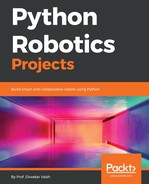Near-field sensing is a very interesting field of sensing. Be prepared for some interesting stuff. If you are feeling a little sleepy, or if you are lacking attention, then get some coffee because the working principle of this system is going to be a little new.
Whenever there is a charge, there is an associated electrical field that comes along with it. These charges propagate through the space and go around an object. When that happens, the electric field associated with it has a specific characteristic. This characteristic will be the same till the time the environment around it is empty.
For the gesture-recognition board that we are using, the field that would be sensed around it is only for about a few centimeters, so anything beyond that point can be disregarded. If there is nothing in that vicinity, then we can safely assume that the pattern of electric field being sensed would be unchanged. However, whenever an object such as our hand comes in the vicinity, then these waves are distorted. The distortion is directly linked to the position of the object and its position. With this distortion, we can sense where the finger is, and with constant sensing, we see what kind of motion is being performed. The board in question looks like this:

The central criss-crossed area on the board is the transmitter and on the extreme sides are rectangular structures that are four in number. These are the sensing elements. These sense the pattern of waves in the space. Based on it, they can derive what are the x, y, and z coordinates of the object. This is powered by a chip named MGC 3130. This does all the computation and delivers the raw reading to the user, regarding the coordinates.
